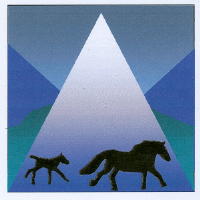Listening to Rose
/When I stepped outside just after sundown, I could see the mares up on the flat to the east of my house. I climbed to them and realized it was windier and colder than I’d expected, so I was motivated to get to the barn as quickly as possible.
I asked my Fell Pony mare Willowtrail Wild Rose to carry me to the head of the trail down the hill. I also asked her to take care of me since I hadn’t worn a helmet. I mounted, and she carried me about one hundred feet then stopped and wouldn't walk again. I assumed it was the cold wind bothering her.
When I ask for Rose to take care of me, I have to accept that a refusal like this is because she's doing as I asked, so I dismounted and started leading her to the edge of the hill. After walking another hundred feet, she stopped and looked as you see here. I followed her gaze and saw that there were seven bull elk on the side of the far hill. From their direction of travel, they likely were closer to us when Rose first refused. She saw them; I didn't. She had determined that she couldn't take care of me and monitor the elk's movement. So she refused to carry me any closer. Fair enough!
© Jenifer Morrissey, 2024

































